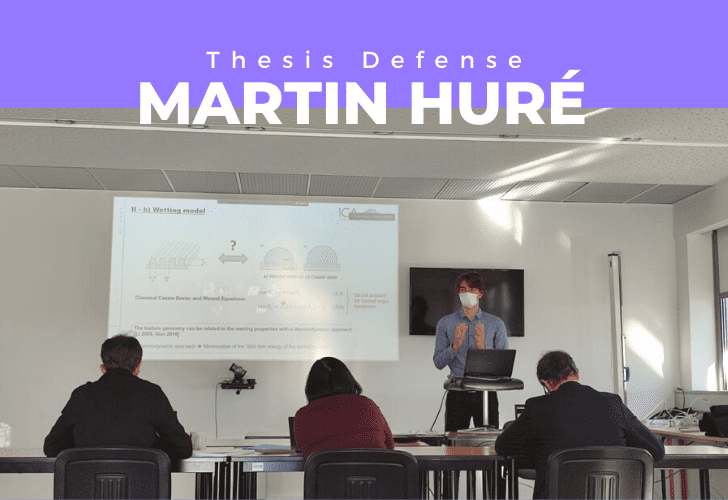On January 14th, 2022, Martin Huré defended his thesis at the Espace Clément Ader institute in Toulouse. His work was supervised by the Clément Ader Institute, the IRT Saint Exupéry and the MEGEP (Mécanique, Energétique, Génie civil & Procédés) Doctoral School. The high quality and the relevance of Martin’s thesis contributed to get significant results as a part of FREEzING project.
ABOUT HIS THESIS
“Development and modeling of engineered surfaces with low ice adhesion properties for an aeronautical application”
Abstract
In-flight icing has been a major threat to aircraft safety since the beginning of aviation. The build-up of ice upon the aerodynamic surfaces of planes can lead to increased weight, along with reduced lift and thrust. In case of prolonged exposure, the aircraft may stall and recovery may be impossible. A widespread approach to mitigate the risk related to atmospheric icing consists of distributing hot air bled from the engines to wings, tails and air inlet. Although very effective, de-icing methods consume a significant amount of energy. This is becoming increasingly of concern as the need of commercial aircraft with reduced environmental footprint is pressing.
In the last twenty years, a widespread interest has been given to icephobic coatings enabling to passively delay ice formation, to lower ice adhesion and to facilitate water droplet shedding before it freezes onto aircrafts outer surfaces. A comprehensive understanding of the mechanisms from which surface properties enable icephobicity is a prerequisite to design efficient ice-repellent coatings. This is particularly true in the field of aircraft icing, as the cost of replicating atmospheric icing conditions in laboratory limits trials and errors testing strategies.
Although efforts were made to predict icephobicity from surface wetting properties, papers present contradictory results. As such, the relationship between ice-repellency and wettability remains an open problem. The consideration of surface roughness makes the analysis more complex, as it induces mechanical locking phenomenon at the ice/substrate interface. This is especially true for superhydrophobic surfaces exhibiting micro/nano-texture. However, the mechanical interactions between the surface texture and ice are poorly understood, and to date, numerical models accounting for the effect of microtexture on ice adhesion do not exist. Another major concern for the implementation of icephobic surfaces on aircraft is their durability, which remains barely investigated.
The wetting properties and shear ice adhesion strength of twenty coatings were characterized, and the relationship between both of these physical properties was studied. Sample surfaces were subjected to four-point bending test to measure the energy release rate at the interface with ice. The data were compared to results obtained with a finite element model comprising cohesive elements to simulate the interface. Good agreement between experimental and numerical results was found, thus showing the relevance of the cohesive zone modelling techniques. Then, a superhydrophobic surface was designed with a thermodynamic model, and manufactured with a nanosecond laser on AA 2024 substrates. Shear ice adhesion strength measurement were performed, along with fractography analyses to assess the mode of fracture.
Based on these observations, a semi-analytical approach was proposed to model the effect of the microstructure on ice adhesion. This approach provided values in good agreement with experimental results, and could be further developed to implement the behavior of superhydrophobic surfaces into de-icing models of more complex system, such as airfoil. Finally, the rain erosion resistance of microtextured aluminum and titanium substrates was investigated.
ABOUT FREEzING PROJECT
The FREEzING project aims to develop and evaluate the glaciophobic properties of coatings elaborated by various surface treatment processes (dry and wet process) for aeronautical applications. The goal is to provide durable anti-icing properties to the treated surfaces. This project also focuses on the development and evaluation of the fire protection properties of ceramic coatings elaborated by various surface treatment processes (dry and wet process) for aeronautical applications. Eventually, FREEzING also develops electrically insulating carbon fiber coatings in acoustic cavities of composite panels.
JURY
| Philippe OLIVIER | Thesis Director | University Toulouse III |
| Julien GARCIA | Thesis Co-Director | IRT Saint Exupéry |
| Elmar BONACCURSO | Examiner | Airbus Germany |
| Xiaojing GONG-HU | Examiner | University Toulouse III |
| Zhiliang ZHANG | Reviewer | Norwegian University of Science and Technology |
| Gelareh MOMEN | Reviewer | Université du Québec à Chicoutimi |
| Marc BUDINGER | Guest | INSA Toulouse |
Scientific publication
M. Huré, P. Olivier, J. Garcia 2022. Effect of Cassie-Baxter versus Wenzel states on ice adhesion: A fracture toughness approach – Cold Regions Science and Technology

